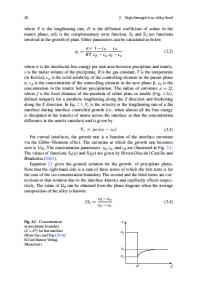Elephant ivory: A low thermal conductivity, high strength nanocomposite
- PDF / 123,287 Bytes
- 6 Pages / 612 x 792 pts (letter) Page_size
- 64 Downloads / 370 Views
Mary Anne Whitea) Institute for Research in Materials and Departments of Physics and Chemistry, Dalhousie University, Halifax, NS, Canada B3H 4J3 (Received 21 June 2005; accepted 21 October 2005)
There has been much recent interest in heat transport in nanostructures, and also in the structure, properties, and growth of biological materials. Here we present measurements of thermal properties of a nanostructured biomineral, ivory. The room-temperature thermal conductivity of ivory is anomalously low in comparison with its constituent components. Low-temperature (2–300 K) measurements of thermal conductivity and heat capacity reveal a glass-like temperature dependence of the thermal conductivity and phonon mean free path, consistent with increased phonon-boundary scattering associated with nanostructure. These results suggest that biomineral-like nanocomposite structures could be useful in the design of novel high-strength materials for low thermal conductivity applications.
I. INTRODUCTION
Recent investigations of heat transport in nanostructures have been motivated by the miniaturization of electronic components and, more fundamentally, because nanoscale phononic heat transfer is different from macroscale conduction. The reduced thermal conductivities commonly observed in nanostructured materials, in part due to increased importance of phonon-boundary scattering, make them particularly promising candidates for low thermal conductivity applications, such as improved thermoelectrics. Chen,1 Cahill et al.,2 and Balandin,3 provide detailed discussions of the theory of nanoscale heat conduction and reviews of experimental results. Ivory is a natural nanocomposite with a complex hierarchical structure,4,5 and, unlike many synthetic nanomaterials, sufficiently large samples are available for bulk measurements, which could be used to assess nanostructural effects on thermal conductivity. In addition to its natural beauty, the historical appeal of ivory for sculptures and utensils is related to its firmness, rigidity, and elasticity, all stemming from its composition and unique structure. Biomineral composites such as bone, shell, and teeth also have appealing
a)
Address all correspondence to this author. e-mail: [email protected] DOI: 10.1557/JMR.2006.0029 J. Mater. Res., Vol. 21, No. 1, Jan 2006
http://journals.cambridge.org
Downloaded: 13 Mar 2015
mechanical properties; furthermore, they are produced from common, non-toxic compounds (e.g., calcium carbonate, calcium phosphate, silica, and iron oxide)6 under mild conditions. While researchers have traditionally optimized performance through choice of chemical composition, Nature achieves optimum performance through structural shapes and complex hierarchical organization using relatively few chemically different substances.7,8 As such, delineation of the structure, properties, and growth mechanisms of Nature’s materials could provide both insight and inspiration for the development of new materials. Although the elegance of Nature’s solutions are well recogniz
Data Loading...










